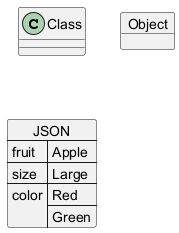An
object diagram is a graphical representation that showcases objects and their relationships at a specific moment in time. It provides a snapshot of the system's structure, capturing the static view of the instances present and their associations.
PlantUML offers a simple and intuitive way to create object diagrams using plain text. Its user-friendly syntax allows for quick diagram creation without the need for complex GUI tools. Moreover, the
PlantUML forum provides a platform for users to discuss, share, and seek assistance, fostering a collaborative community. By choosing PlantUML, users benefit from both the efficiency of markdown-based diagramming and the support of an active community.
You define instances of objects using the
object
keyword.
|
🎉 Copied!


|
@startuml
object firstObject
object "My Second Object" as o2
@enduml
|
Relations between objects are defined using the following symbols :
|
Type
|
Symbol
|
Purpose
|
|
Extension
|
<|--
|
Specialization of a class in a hierarchy
|
|
Implementation
|
<|..
|
Realization of an interface by a class
|
|
Composition
|
*--
|
The part cannot exist without the whole
|
|
Aggregation
|
o--
|
The part can exist independently of the whole
|
|
Dependency
|
-->
|
The object uses another object
|
|
Dependency
|
..>
|
A weaker form of dependency
|
It is possible to replace
-- by
.. to have a dotted line.
Knowing those rules, it is possible to draw the following drawings.
It is possible a add a label on the relation, using
: followed by the text of the label.
For cardinality, you can use double-quotes
"" on
each side of the relation.
|
🎉 Copied!


|
@startuml
object Object01
object Object02
object Object03
object Object04
object Object05
object Object06
object Object07
object Object08
Object01 <|-- Object02
Object03 *-- Object04
Object05 o-- "4" Object06
Object07 .. Object08 : some labels
@enduml
|
|
🎉 Copied!


|
@startuml
object o1
object o2
diamond dia
object o3
o1 --> dia
o2 --> dia
dia --> o3
@enduml
|
To declare fields, you can use the symbol
: followed by
the field's name.
|
🎉 Copied!


|
@startuml
object user
user : name = "Dummy"
user : id = 123
@enduml
|
It is also possible to group all fields between brackets
{}.
|
🎉 Copied!


|
@startuml
object user {
name = "Dummy"
id = 123
}
@enduml
|
You can define a map table or
associative array, with
map keyword and
=> separator.
|
🎉 Copied!


|
@startuml
map CapitalCity {
UK => London
USA => Washington
Germany => Berlin
}
@enduml
|
|
🎉 Copied!


|
@startuml
map "Map **Contry => CapitalCity**" as CC {
UK => London
USA => Washington
Germany => Berlin
}
@enduml
|
|
🎉 Copied!


|
@startuml
map "map: Map<Integer, String>" as users {
1 => Alice
2 => Bob
3 => Charlie
}
@enduml
|
And add link with object.
|
🎉 Copied!


|
@startuml
object London
map CapitalCity {
UK *-> London
USA => Washington
Germany => Berlin
}
@enduml
|
|
🎉 Copied!


|
@startuml
object London
object Washington
object Berlin
object NewYork
map CapitalCity {
UK *-> London
USA *--> Washington
Germany *---> Berlin
}
NewYork --> CapitalCity::USA
@enduml
|
[Ref. #307]
|
🎉 Copied!


|
@startuml
package foo {
object baz
}
package bar {
map A {
b *-> foo.baz
c =>
}
}
A::c --> foo
@enduml
|
[Ref. QA-12934]
|
🎉 Copied!


|
@startuml
object Foo
map Bar {
abc=>
def=>
}
object Baz
Bar::abc --> Baz : Label one
Foo --> Bar::def : Label two
@enduml
|
[Ref. #307]
You can use
map table in order to make
Program (or project) evaluation and review technique (PERT) diagram.
|
🎉 Copied!


|
@startuml PERT
left to right direction
' Horizontal lines: -->, <--, <-->
' Vertical lines: ->, <-, <->
title PERT: Project Name
map Kick.Off {
}
map task.1 {
Start => End
}
map task.2 {
Start => End
}
map task.3 {
Start => End
}
map task.4 {
Start => End
}
map task.5 {
Start => End
}
Kick.Off --> task.1 : Label 1
Kick.Off --> task.2 : Label 2
Kick.Off --> task.3 : Label 3
task.1 --> task.4
task.2 --> task.4
task.3 --> task.4
task.4 --> task.5 : Label 4
@enduml
|
[Ref. QA-12337]
Simple example
|
🎉 Copied!


|
@startuml
class Class
object Object
json JSON {
"fruit":"Apple",
"size":"Large",
"color": ["Red", "Green"]
}
@enduml
|
[Ref. QA-15481]
For another example, see on
JSON page.












